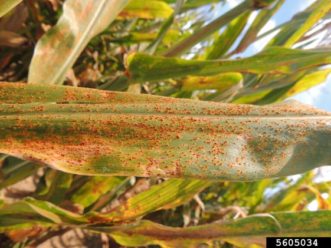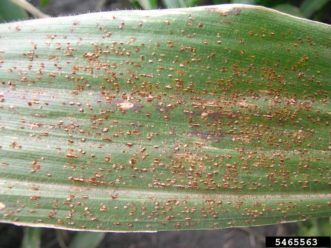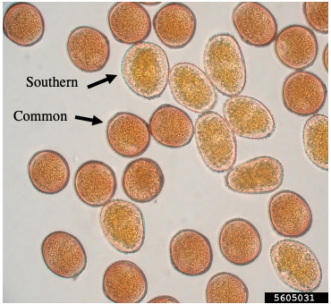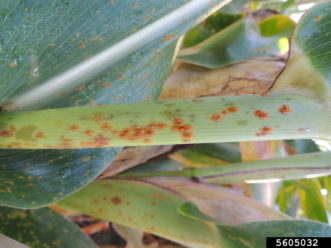Identifying and distinguishing between common and southern rust is important for proper corn management. This guide is to help growers, consultants, researchers, and Extension personnel correctly identify and manage common and southern rust.
Rusts are fungal diseases that affect a wide host range of crops worldwide. In the United States and specifically the southern United States, two rusts, common rust (Puccinia sorghi) and southern rust (Puccinia polysora), are known to affect corn (Zea mays).1,2 Although both diseases can cause yield reductions, common rust is much less aggressive and must be present at high levels to cause a yield loss. However, if present at critical corn growth stages, southern rust can lead to dramatic yield reductions due to losses in the photosynthetic capacity of the leaves.2
Symptoms and Signs
Both common and southern rust begin as small lesions on the leaves that develop a pale green to yellow halo.2,5 As these lesions mature, the fungi erupt through the epidermal tissue to form raised spore-producing structures called pustules, which produce reddish or “rust” colored urediniospores.
On infected corn, common rust pustules are typically brown to red in color, elongated in shape, and appear on the upper and lower leaf surfaces (figure 1).2 However, southern rust pustules are orange to tan in color, with pustules having a circular to oval appearance and are typically only present on the upper leaf surface (figure 2).2 As these pustules mature, they give rise to urediniospores. In common rust, urediniospores are circular in shape and red to brown in color, whereas in southern rust, urediniospores are circular to oval in shape and orange to tan in color (figure 3).2 In severe cases, southern rust pustules can also be found infecting husks and the leaf tissue that wraps around stalks in addition to leaves (figure 4).2
Environmental Conditions for Disease
In South Carolina, common rust infection typically occurs earlier in the corn growing season (April–June), prior to tasseling, due to cool and moist environmental conditions favoring disease development, with optimum temperature ranging from 61 °F to 77 °F (16 °C to 25 °C).2 Hot, dry conditions can limit common rust development, resulting in pustules becoming inactive. In contrast, southern rust typically occurs later in the growing season (July–September), typically after tasseling, when temperatures reach ranges of 77 °F to 82 °F (25 °C to 27 °C) and high relative humidity is present.2 Both diseases can infect the host plant after approximately six hours of leaf wetness, typically a heavy dew.2 However, periods of frequent rainfall can promote severe disease development, especially when it comes to southern rust.
Disease Cycle
Rusts require living host tissue to survive and complete their life cycle. Once corn has matured, and foliar tissue has dried down, the fungi cannot survive in corn debris present between seasons.1,2,5 However, common rust can survive on several Oxalis spp., such as creeping woodsorrel (O. corniculate) and common yellow woodsorrel (O. stricta), as an alternative host.4 In South Carolina, these hosts produce limited amounts of primary inoculum the following spring. Each year, wind currents from tropical climates deliver common and southern rust spores into corn-producing regions of the United States.1,2 Once the corn plant is infected, these pathogens can develop spore-producing pustules in seven to fourteen days, which can lead to secondary infections.2 Typically, these diseases appear first in the southern United States and, as favorable conditions arise, spread throughout the corn growing season via wind currents into South Carolina and, in some years, even into northern corn-producing states.2,5 When conditions are just right, the fungus produces teliospores, which are dark brown to black, and in rare instances, can be seen on leaves late in the season in South Carolina.2 However, even in these fields, most of the primary and secondary inoculum (urediniospores) blows in from other areas.
Management
Typically, common rust has a limited impact on yield, with normal levels of common rust not requiring fungicide sprays. Hybrids resistant to common rust are available and provide good control for no added expense. In cases where large amounts of inoculum are present and environmental conditions are favorable, fungicides may be necessary to achieve effective control (see table 1 – link to PDF download file).2,6 With southern rust, scouting corn to detect infection early in the growing season is essential. Management of southern rust begins with planting a resistant hybrid and being prepared to apply a fungicide if needed (table 1).
Fungicide applications should be applied at or around the tasseling or silking growth stage, or VT/R1, as a preventative spray. These applications are commonly applied via aerial application, ground application, and chemigation through a center pivot.3 Using tools such as the Corn ipmPIPE website (corn.ipmpipe.org/southerncornrust/), which tracks southern rust observations throughout the growing season, can be helpful in making informed management decisions. For a complete list of suggested fungicides to control foliar diseases on corn, review the Crop Protection Network’s Fungicide Efficacy for Control of Corn Diseases (bit.ly/3uFheHa).6
Growers should be careful when utilizing any fungicide to be aware of the mode of action (MOA). Multiple applications of fungicides with the same MOA within a growing season may select for populations of the fungus resistant to that MOA or fungicide, making management in the future more difficult. Fungicides with multiple MOAs are often more effective in providing disease control and help with fungicide resistance management but can also be more expensive.
References Cited
- Dolezal W, Tiwari K, Kemerait R, Kichler J, Sapp P, Pataky J. An unusual occurrence of southern rust caused by Rpp9-virulent Puccinia polysora, on corn in southwestern Georgia. Plant Disease. 2009 Jun;93(6):676.
- Munkvold G P, White DG, editors. Compendium of corn diseases. 4th ed. St. Paul (MN): American Phytopathological Society; 2016.
- Plumblee MT, editor. 2022 South Carolina corn production guide. Clemson (SC): Clemson University Cooperative Extension Service. https://www.clemson.edu/extension/agronomy/corn.html.
- Thiessen L, Rivera RY, Kinczyk J. Corn rust: common and southern rust. Raleigh (NC): North Carolina State Extension, NCSU Field Crops and Tobacco Pathology Lab; 2018.
- Wise KA. Diseases of corn: common and southern rusts. West Lafayette (IN); Purdue University Extension; 2010. BP-82-W. https://www.extension.purdue.edu/extmedia/BP/BP-82-W.pdf.
- Wise KA. Fungicide efficacy for control of corn diseases. Ames (IA): Crop Protection Network, Corn Disease Working Group; 2022. CPN-2011. doi:10.31274/cpn-20190620-002.





